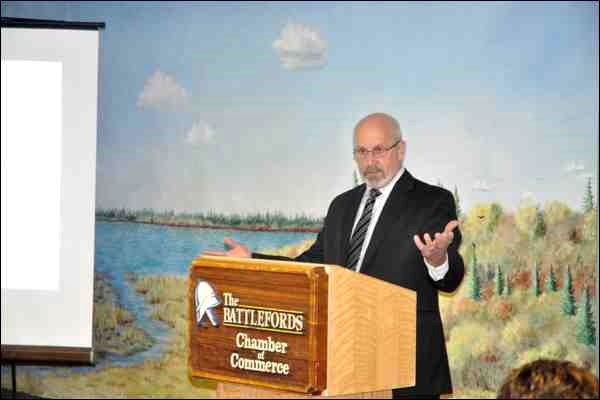Building bigger and better urban regions is key to a stable economic base for Saskatchewan in the future.
That was the message conveyed Wednesday by Blaine Canitz of Cynosure Business Development Group Inc. to a luncheon hosted by the Battlefords Chamber of Commerce.
Canitz was there to deliver the findings of an Institute of Certified Management Consultants of Saskatchewan study on the future growth of the province.
The report found that the bulk of the growth - 80 per cent, according to the presentation - was in the cities.
"We are in a commodity supercycle where all of those resources are going at once," Canitz told reporters after his presentation.
"Those resources all originate out in the rural area, but what we found out is a lot of those workers that are drawing those resources out in the rural area live primarily in the eight largest cities in the province and North Battleford is one of those."
According to his presentation, the key to future growth was through the creation of larger urban regions. Canitz made the point that bigger and better cities would provide a stronger economic base for people throughout the province regardless of location.
According to the ICMCS study, cities with metro populations of 500,000 or more become "self-sustaining economic engines."
These cities, described as "large economic urban regions," offer more infrastructure and can attract more businesses, he noted.
"That 500,000 figure is important because when we can start attracting head offices, you can bring the people in and attract some of the amenities that somebody who wants to live in a larger centre," said Canitz.
He noted that the 500,000 number was not an arbitrary figure. It was one identified in studies as a cutoff for an economy to support itself.
"You had enough critical mass, enough buying power in there that it could weather occasional downturns."
Even North Battleford would benefit, he noted, from its proximity to Saskatoon due to its location on the Yellowhead corridor.
"I've worked with businesses in North Battleford with a very good highway between here and Saskatoon," said Canitz, noting that goods flow back and forth between the two communities.
To benefit fully in the years ahead will not be easy, noted Canitz. Some of the challenges that need to be overcome, he said, include issues of infrastructure, addressing the rising costs of living, training and attracting more skilled and professional workers and continuing to improvement and evolve the policy environment.
The framework to follow, he suggested, includes adopting a strategic approach, planning for growth and change integrating environmental thinking, ensuring there are opportunities for all, rigorously managing costs and exploring partnerships.
Canitz noted the importance of communities working together to "recognize the big picture. It's not just within a city limits, but also the outlying areas and even the economic corridors that have to work together."
He also warned against communities "developing little fiefdoms. You've seen a little bit of that in some of the cities where they may wind up in an argument with an RM about how they develop things. That's counterproductive."
He suggested municipalities work together and come up with a plan and recognize that each has something to offer.
"There will be disagreements but they have to get by those."




